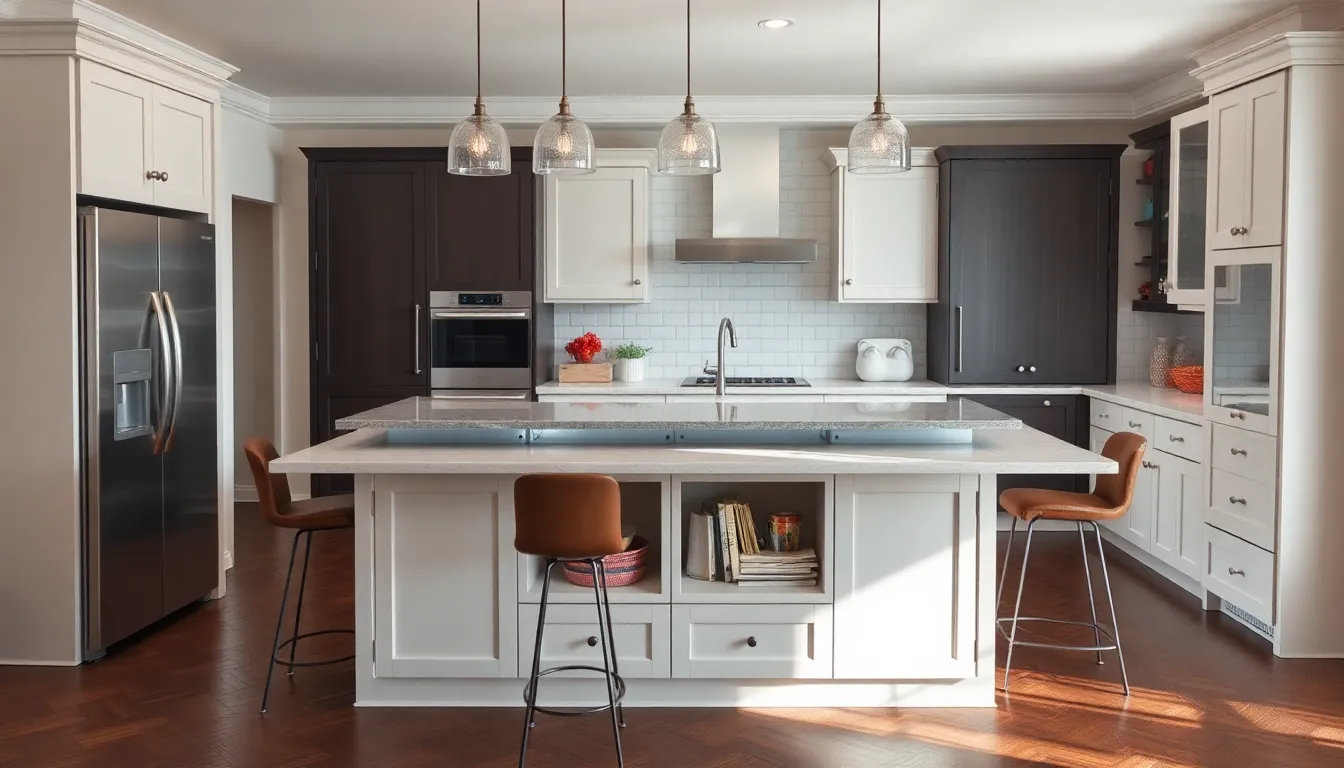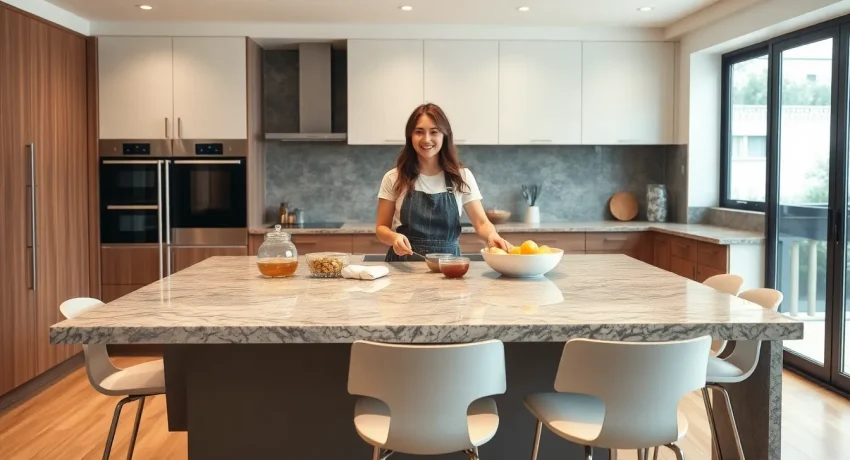Picture this: a culinary command center that’s not just a place to chop veggies but a stylish hub for family gatherings, late-night snacks, and maybe a little too much wine. Kitchen islands have transformed from mere countertops into the heart of the home, where creativity simmers and conversations flow.
Table of Contents
ToggleOverview of Kitchen Islands
Kitchen islands have transformed into essential components of modern kitchens. Serving multiple purposes, they act as cooking surfaces, dining areas, and social hubs within homes. Their size and shape vary significantly, catering to different kitchen layouts and personal preferences.
Countertop materials for kitchen islands include granite, quartz, and marble, each offering distinct aesthetics and durability. Many homeowners select materials based on functionality and maintenance requirements. Designs range from minimalist styles to elaborate setups, featuring cabinetry and seating arrangements.
Seating options play a crucial role in creating a welcoming atmosphere. Bar stools and chairs often accompany islands, allowing family and guests to gather comfortably. These spaces encourage interaction, making kitchens more inviting for socialization.
Appliances can also integrate into kitchen islands, providing convenience and efficiency. Built-in cooktops, sinks, and dishwashers save floor space while enhancing overall functionality.
Storage solutions within islands increase kitchen organization. Drawers, cabinets, and shelves provide ample space for utensils, pots, and pans. Effective use of space makes every kitchen island a highly functional and valuable addition.
Lighting fixtures above kitchen islands add ambiance and illumination. Pendant lights or chandeliers serve as eye-catching focal points while offering practical lighting for cooking and dining activities.
With their multifunctional roles and diverse designs, kitchen islands continue to grow in popularity. Integrating them into home layouts enhances both aesthetics and practicality, solidifying their status as indispensable elements in contemporary kitchen design.
Types of Kitchen Islands

Kitchen islands come in various styles, each suiting specific needs and preferences. Understanding the types helps homeowners choose the best fit for their kitchen.
Mobile Kitchen Islands
Mobile kitchen islands provide versatility and flexibility. These islands usually feature wheels or casters, allowing for easy relocation within the kitchen. Homeowners often use them for extra countertop space during meal prep or as serving areas during gatherings. Smaller kitchens benefit significantly from their adaptability, making them ideal for limited spaces. Capable of fitting into different areas, mobile islands can also serve as temporary storage solutions.
Fixed Kitchen Islands
Fixed kitchen islands anchor the kitchen with stability and style. These permanent installations typically include more extensive countertop areas and built-in storage options. Many homeowners incorporate appliances like microwaves or wine coolers within fixed islands, enhancing functionality. The size and design of these islands can complement the overall kitchen décor, making them a focal point. Fixed islands often offer ample seating, encouraging social interaction during cooking and entertaining.
Custom-Built Kitchen Islands
Custom-built kitchen islands provide tailored solutions for unique kitchen layouts. These islands are designed to meet specific preferences and dimensions, maximizing both aesthetics and utility. Custom options may include specialized cabinets, unique countertop materials, or integrated appliances. Homeowners enjoy personalizing every detail to align with their design vision. Such flexibility allows for creative solutions in kitchens of all shapes and sizes, ensuring each island serves its intended purpose effectively.
Benefits of Kitchen Islands
Kitchen islands offer multiple advantages that enhance both functionality and design in modern kitchens.
Additional Storage Space
Storage solutions within kitchen islands significantly benefit homeowners. They often feature cabinets, drawers, and shelves that accommodate kitchen essentials. This added space helps with organization, making it easier to find cooking tools and ingredients. Homeowners can store pots, pans, and utensils within reach. Custom designs allow for creative storage options, such as pull-out shelves for easy access. This organization reduces countertop clutter, leading to a more efficient cooking environment. Overall, kitchen islands serve as practical solutions to common storage challenges.
Increased Counter Space
Counter space increases significantly with the introduction of a kitchen island. It provides an additional area for meal preparation, allowing for more tasks to be completed simultaneously. Home cooks appreciate having space to chop vegetables or assemble dishes without feeling cramped. Extended countertops often accommodate breakfast bars and other dining setups, making them versatile. The flow of food preparation benefits from this extra space, as it allows for the placement of appliances without sacrificing usable area. Enhanced counter space fosters a more enjoyable cooking experience and improves kitchen functionality.
Enhanced Social Interaction
Social interaction thrives with kitchen islands as central hubs of activity. They create inviting environments for family and friends, encouraging conversation during meal preparation. People enjoy gathering around the island while engaging in cooking or sharing snacks, which fosters connections. Seating options make kitchen islands even more appealing, allowing for casual dining and informal gatherings. This design element contributes to a welcoming atmosphere that extends beyond traditional dining spaces. Enhanced social interaction elevates the overall kitchen experience, turning cooking into a shared activity.
Choosing the Right Kitchen Island
Selecting the ideal kitchen island involves careful consideration of size, materials, and design. Each of these aspects enhances functionality and aesthetics in the kitchen.
Size and Layout Considerations
Choosing the right size hinges on available space. Measure the kitchen layout to ensure the island fits comfortably without obstructing traffic. Typically, islands should offer at least 42 inches of clearance from surrounding surfaces. A proportionate design complements the overall kitchen size, making the space appear balanced. Smaller kitchens benefit from mobile or compact islands that provide flexibility. Conversely, larger kitchens allow for more substantial fixed islands, enabling multiple activities simultaneously.
Material Options
Various countertop materials cater to diverse preferences and needs. Granite and quartz provide durability and diverse aesthetic options, making them popular choices. Homeowners often consider marble for its elegance but note the maintenance required. Additionally, butcher block surfaces appeal to those who appreciate a warm, natural feel. Selecting island materials that align with existing kitchen finishes ensures cohesive design. Considering functionality, opt for non-porous materials that resist stains and damage, especially in high-use areas.
Style and Design
Different stylistic choices define the island’s visual impact. Contemporary kitchens often feature minimalist designs, emphasizing clean lines and sleek finishes. Traditional styles incorporate ornate details, conveying warmth and comfort. Mixing and matching styles can create unique looks; however, maintaining a consistent theme throughout the kitchen promotes harmony. Custom features, like integrated shelving or unique lighting, enhance the island’s design and functionality further. Ultimately, selecting a style that resonates with the homeowner’s taste enhances the kitchen’s overall appeal.
Maintenance and Care for Kitchen Islands
Maintaining a kitchen island involves regular cleaning, proper care of materials, and minor repairs. Owners need to dust countertops frequently to prevent buildup. Wipe surfaces with a damp cloth and a gentle cleaner to keep them looking pristine. For granite and quartz, using a pH-balanced cleaner ensures no damage occurs.
Sealing surfaces is essential for natural stone countertops. Homeowners should reseal granite and marble every six months to a year, depending on usage. This practice strengthens resistance to stains and moisture damage. For butcher block, applying mineral oil every month helps maintain its integrity, preventing drying and cracking.
Attending to the hardware and fixtures is equally important. Tightening screws on cabinets and drawers ensures smooth operation. Replacing any damaged or rusted handles improves both functionality and appearance. For appliances integrated into the island, regular checks for functionality can help identify issues early.
Using cutting boards will protect surfaces from scratches. Placing hot pots on trivets prevents heat damage. These simple practices prolong the lifespan of kitchen islands and maintain aesthetics.
Addressing spills immediately minimizes staining risks. Promptly cleaning up acidic or colored liquids preserves the beauty of the countertops. Using coasters under glasses prevents water rings on wooden surfaces.
Taking a proactive approach to maintenance not only enhances the island’s longevity but also contributes to the overall kitchen environment. Owners who’ve invested time in care enjoy a more inviting and functional space, reinforcing the island’s status as a centerpiece in kitchen design.
Conclusion
Kitchen islands have transformed into essential features that elevate both the functionality and aesthetic of modern kitchens. Their versatility allows for creative design choices that cater to individual needs while enhancing social interactions. As homeowners consider the various types of islands and materials, they can create a space that reflects their personal style and meets practical demands.
With proper maintenance and thoughtful design, kitchen islands can serve as lasting focal points that bring families together. Investing in a well-planned kitchen island not only boosts organization and efficiency but also enriches the overall home experience. Embracing this trend can lead to a more inviting and enjoyable kitchen environment for all.




